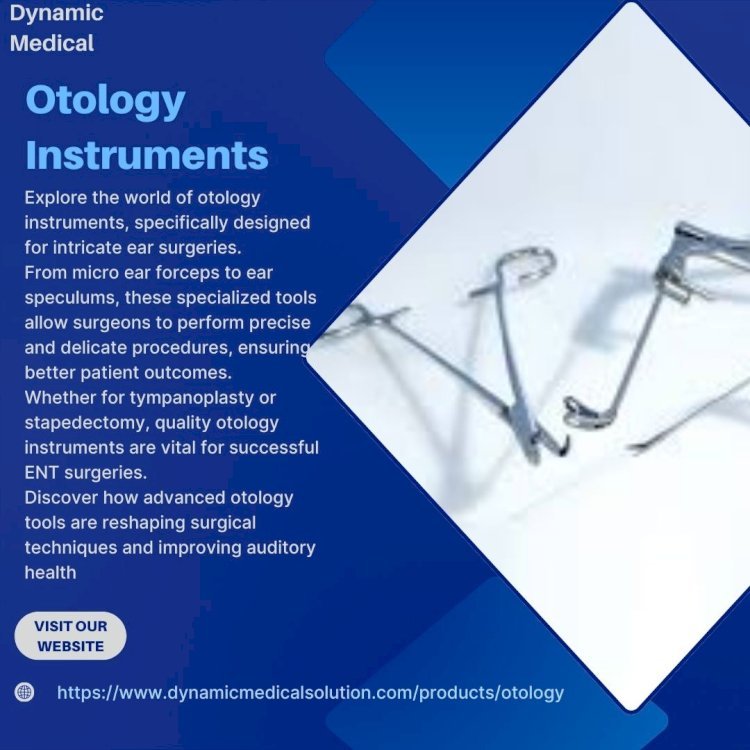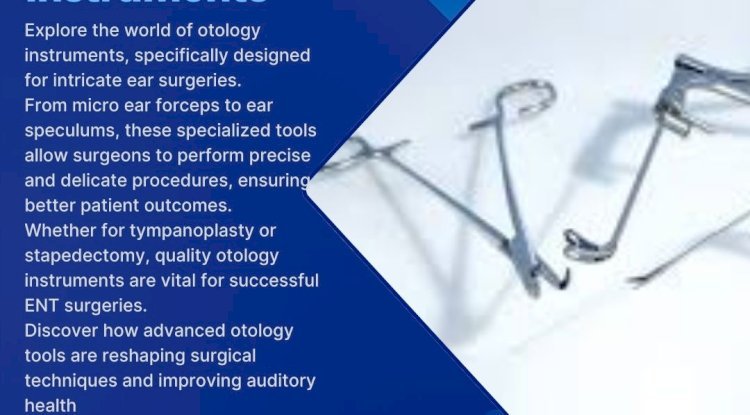Types of Otology Instruments in ENT Care

Types of Otology Instruments in ENT Care
In the field of ENT otology, a wide range of otology instruments is used for the diagnosis, treatment, and surgical intervention of ear-related conditions. These specialized ENT instruments are designed to handle the delicate and complex structures of the ear, ensuring precision and safety during various medical procedures. Understanding the different types of otology instruments is crucial for ENT specialists, as each tool plays a specific role in enhancing patient care. In this article, we explore the most commonly used otology instruments and their functions.
Diagnostic Otology Instruments
Otoscope
The otoscope is one of the most commonly used diagnostic tools in ENT otology. It allows doctors to visually examine the ear canal and eardrum with the help of magnification and a light source. Otoscopes are essential for identifying issues such as infections, eardrum perforations, or blockages caused by earwax. Some advanced otoscopes are also equipped with video capabilities, providing detailed images for more precise diagnosis.
Tuning Forks
Tuning forks are simple yet effective tools used in ENT otology to assess a patient’s hearing. By striking the fork and placing it near the ear or on the head, ENT specialists can determine the type and extent of hearing loss. Tuning forks help distinguish between conductive hearing loss, which affects the outer or middle ear, and sensorineural hearing loss, which involves the inner ear or auditory nerve.
Surgical Otology Instruments
Myringotomy Knife
The myringotomy knife is a small surgical instrument used to make incisions in the eardrum, a procedure often performed to relieve pressure from fluid buildup in the middle ear. This procedure is especially common in treating chronic ear infections. The knife allows for precise incisions, reducing the risk of damage to surrounding tissues and promoting faster recovery.
Micro Ear Forceps
Micro ear forceps are essential surgical tools used to handle delicate tissues and objects within the ear. These forceps are often used during procedures like tympanoplasty (eardrum repair) or stapedectomy (removal of the stapes bone). Their fine, slender tips allow for greater control, enabling ENT surgeons to work with precision during intricate surgeries.
Suction Devices
Suction devices are crucial for removing fluids, earwax, or debris during ear surgeries. In ENT otology, these tools help maintain a clear surgical field, ensuring that the surgeon can see and operate effectively. They are also used in non-surgical procedures to remove excess earwax or discharge caused by infections.
Mastoidectomy Drills
A mastoidectomy drill is used in more complex ear surgeries, particularly when dealing with the mastoid bone located behind the ear. This drill helps ENT surgeons remove infected bone tissue or access the middle and inner ear for various surgical treatments. These high-speed drills are designed for precision, ensuring that the surrounding tissues remain undamaged during surgery.
Therapeutic and Treatment Otology Instruments
Ear Speculum
The ear speculum is a simple yet essential instrument that allows ENT specialists to widen the ear canal for better visualization. It is often used during diagnostic exams, ear cleaning, or when performing minor surgical procedures. Ear speculums come in various sizes, making them suitable for both adult and pediatric patients.
Ear Curettes
Ear curettes are used for removing earwax buildup or foreign objects from the ear canal. These instruments are designed with a looped or spoon-shaped tip that can safely extract material from the ear without causing injury to the sensitive ear canal walls. ENT specialists rely on ear curettes to ensure thorough cleaning and to avoid complications that could arise from impacted earwax.
Stapes Prosthesis
In cases where the stapes bone in the middle ear becomes damaged or stiff, a stapes prosthesis may be used. This tiny implant replaces the malfunctioning stapes bone, restoring sound transmission and improving hearing. The insertion of a stapes prosthesis is a delicate procedure that requires the use of specialized ENT instruments, ensuring the prosthesis is properly positioned for optimal hearing restoration.
Pediatric Otology Instruments
Pediatric otology instruments are specially designed for children, who often have smaller and more sensitive ear structures. Tools like pediatric ear speculums and micro ear forceps are scaled down to fit a child’s anatomy, ensuring that ENT specialists can perform exams and procedures safely and effectively.
In pediatric care, the use of appropriately sized ENT instruments minimizes discomfort and reduces the risk of complications, especially during procedures like earwax removal or the treatment of ear infections.
Advanced Imaging Instruments in Otology
Endoscope
The endoscope is a highly advanced instrument used in both diagnostics and surgery. It is equipped with a tiny camera that allows ENT specialists to view hard-to-reach areas inside the ear. Endoscopes are particularly useful for examining the middle and inner ear, helping doctors diagnose conditions such as otitis media (middle ear infection) or cholesteatoma (an abnormal skin growth in the middle ear). In surgery, endoscopes offer a minimally invasive approach, providing clear, real-time images that guide the surgeon’s movements.
Audiometer
An audiometer is an instrument used to evaluate a patient’s hearing levels. It plays a key role in diagnosing hearing loss by measuring the ability to hear different frequencies and volumes. Audiometers are essential in determining the type of hearing loss, whether it is conductive, sensorineural, or mixed, and are crucial for developing an appropriate treatment plan.
Conclusion
The variety of otology instruments used in ENT otology is vast, covering everything from diagnostic tools like otoscopes and tuning forks to advanced surgical instruments like micro ear forceps and mastoidectomy drills. Each instrument plays a vital role in ensuring that ENT specialists can provide accurate diagnoses, effective treatments, and precise surgeries for ear-related conditions. As technology continues to advance, the range and functionality of ENT instruments will further expand, offering even greater precision and improved outcomes for patients. For more details visit our website Dynamic medical.

What's Your Reaction?















